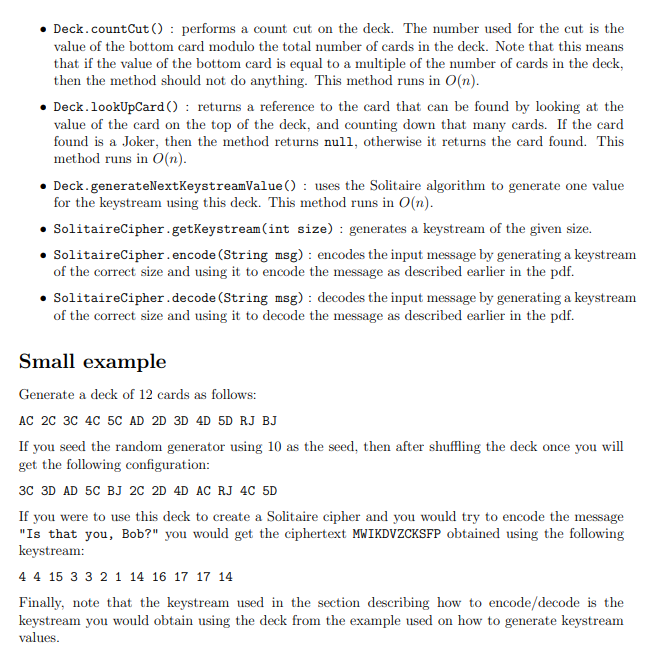Question
Please implement these methods in java using the started code below: DECK CLASS: package assignment2; import java.util.Random; public class Deck { public static String[] suitsInOrder
Please implement these methods in java using the started code below:
DECK CLASS:
package assignment2;
import java.util.Random;
public class Deck { public static String[] suitsInOrder = {"clubs", "diamonds", "hearts", "spades"}; public static Random gen = new Random();
public int numOfCards; // contains the total number of cards in the deck public Card head; // contains a pointer to the card on the top of the deck
/* * TODO: Initializes a Deck object using the inputs provided */ public Deck(int numOfCardsPerSuit, int numOfSuits) { /**** ADD CODE HERE ****/ }
/* * TODO: Implements a copy constructor for Deck using Card.getCopy(). * This method runs in O(n), where n is the number of cards in d. */ public Deck(Deck d) { /**** ADD CODE HERE ****/ }
/* * For testing purposes we need a default constructor. */ public Deck() {}
/* * TODO: Adds the specified card at the bottom of the deck. This * method runs in $O(1)$. */ public void addCard(Card c) { /**** ADD CODE HERE ****/ }
/* * TODO: Shuffles the deck using the algorithm described in the pdf. * This method runs in O(n) and uses O(n) space, where n is the total * number of cards in the deck. */ public void shuffle() { /**** ADD CODE HERE ****/ }
/* * TODO: Returns a reference to the joker with the specified color in * the deck. This method runs in O(n), where n is the total number of * cards in the deck. */ public Joker locateJoker(String color) { /**** ADD CODE HERE ****/ return null; }
/* * TODO: Moved the specified Card, p positions down the deck. You can * assume that the input Card does belong to the deck (hence the deck is * not empty). This method runs in O(p). */ public void moveCard(Card c, int p) { /**** ADD CODE HERE ****/ }
/* * TODO: Performs a triple cut on the deck using the two input cards. You * can assume that the input cards belong to the deck and the first one is * nearest to the top of the deck. This method runs in O(1) */ public void tripleCut(Card firstCard, Card secondCard) { /**** ADD CODE HERE ****/ }
/* * TODO: Performs a count cut on the deck. Note that if the value of the * bottom card is equal to a multiple of the number of cards in the deck, * then the method should not do anything. This method runs in O(n). */ public void countCut() { /**** ADD CODE HERE ****/ }
/* * TODO: Returns the card that can be found by looking at the value of the * card on the top of the deck, and counting down that many cards. If the * card found is a Joker, then the method returns null, otherwise it returns * the Card found. This method runs in O(n). */ public Card lookUpCard() { /**** ADD CODE HERE ****/ return null; }
/* * TODO: Uses the Solitaire algorithm to generate one value for the keystream * using this deck. This method runs in O(n). */ public int generateNextKeystreamValue() { /**** ADD CODE HERE ****/ return 0; }
public abstract class Card { public Card next; public Card prev;
public abstract Card getCopy(); public abstract int getValue();
}
public class PlayingCard extends Card { public String suit; public int rank;
public PlayingCard(String s, int r) { this.suit = s.toLowerCase(); this.rank = r; }
public String toString() { String info = ""; if (this.rank == 1) { //info += "Ace"; info += "A"; } else if (this.rank > 10) { String[] cards = {"Jack", "Queen", "King"}; //info += cards[this.rank - 11]; info += cards[this.rank - 11].charAt(0); } else { info += this.rank; } //info += " of " + this.suit; info = (info + this.suit.charAt(0)).toUpperCase(); return info; }
public PlayingCard getCopy() { return new PlayingCard(this.suit, this.rank); }
public int getValue() { int i; for (i = 0; i
return this.rank + 13*i; }
}
public class Joker extends Card{ public String redOrBlack;
public Joker(String c) { if (!c.equalsIgnoreCase("red") && !c.equalsIgnoreCase("black")) throw new IllegalArgumentException("Jokers can only be red or black");
this.redOrBlack = c.toLowerCase(); }
public String toString() { //return this.redOrBlack + " Joker"; return (this.redOrBlack.charAt(0) + "J").toUpperCase(); }
public Joker getCopy() { return new Joker(this.redOrBlack); }
public int getValue() { return numOfCards - 1; }
public String getColor() { return this.redOrBlack; } }
}
SOLITAIRE CIPHER CLASS:
package assignment2;
public class SolitaireCipher { public Deck key; public SolitaireCipher (Deck key) { this.key = new Deck(key); // deep copy of the deck } /* * TODO: Generates a keystream of the given size */ public int[] getKeystream(int size) { /**** ADD CODE HERE ****/ return null; } /* * TODO: Encodes the input message using the algorithm described in the pdf. */ public String encode(String msg) { /**** ADD CODE HERE ****/ return null; } /* * TODO: Decodes the input message using the algorithm described in the pdf. */ public String decode(String msg) { /**** ADD CODE HERE ****/ return null; } }
Please follow these instructions:


Step by Step Solution
There are 3 Steps involved in it
Step: 1

Get Instant Access to Expert-Tailored Solutions
See step-by-step solutions with expert insights and AI powered tools for academic success
Step: 2

Step: 3

Ace Your Homework with AI
Get the answers you need in no time with our AI-driven, step-by-step assistance
Get Started


